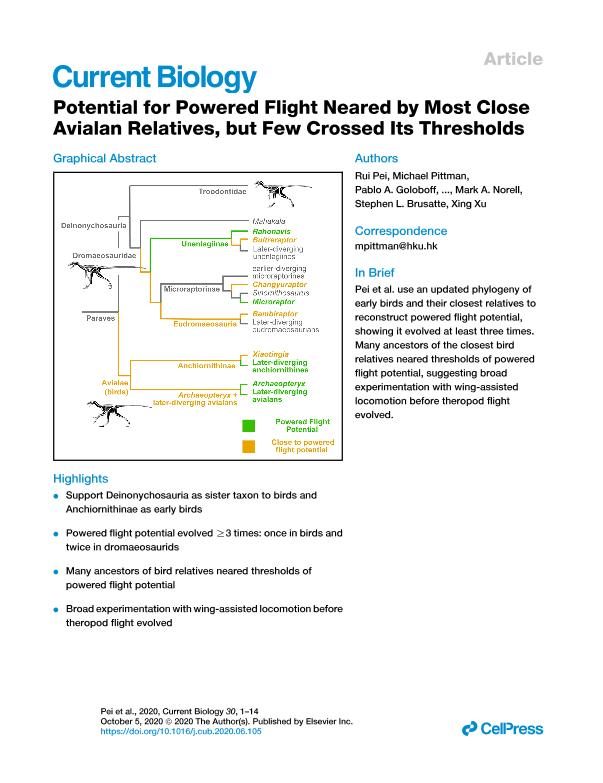Mostrar el registro sencillo del ítem
dc.contributor.author
Pei, Rui
dc.contributor.author
Pittman, Michael B.
dc.contributor.author
Goloboff, Pablo Augusto

dc.contributor.author
Dececchi, T. Alexander
dc.contributor.author
Habib, Michael B.
dc.contributor.author
Kaye, Thomas G.
dc.contributor.author
Larsson, Hans C. E.
dc.contributor.author
Norell, Mark A.
dc.contributor.author
Brusatte, Stephen L.
dc.contributor.author
Xu, Xing

dc.date.available
2021-10-07T14:16:45Z
dc.date.issued
2020-10
dc.identifier.citation
Pei, Rui; Pittman, Michael B.; Goloboff, Pablo Augusto; Dececchi, T. Alexander; Habib, Michael B.; et al.; Potential for Powered Flight Neared by Most Close Avialan Relatives, but Few Crossed Its Thresholds; Cell Press; Current Biology; 30; 20; 10-2020; 4033-4046.e8
dc.identifier.issn
0960-9822
dc.identifier.uri
http://hdl.handle.net/11336/143103
dc.description.abstract
Uncertainties in the phylogeny of birds (Avialae) and their closest relatives have impeded deeper understanding of early theropod flight. To help address this, we produced an updated evolutionary hypothesis through an automated analysis of the Theropod Working Group (TWiG) coelurosaurian phylogenetic data matrix. Our larger, more resolved, and better-evaluated TWiG-based hypothesis supports the grouping of dromaeosaurids + troodontids (Deinonychosauria) as the sister taxon to birds (Paraves) and the recovery of Anchiornithinae as the earliest diverging birds. Although the phylogeny will continue developing, our current results provide a pertinent opportunity to evaluate what we know about early theropod flight. With our results and available data for vaned feathered pennaraptorans, we estimate the potential for powered flight among early birds and their closest relatives. We did this by using an ancestral state reconstruction analysis calculating maximum and minimum estimates of two proxies of powered flight potential—wing loading and specific lift. These results confirm powered flight potential in early birds but its rarity among the ancestors of the closest avialan relatives (select unenlagiine and microraptorine dromaeosaurids). For the first time, we find a broad range of these ancestors neared the wing loading and specific lift thresholds indicative of powered flight potential. This suggests there was greater experimentation with wing-assisted locomotion before theropod flight evolved than previously appreciated. This study adds invaluable support for multiple origins of powered flight potential in theropods (≥3 times), which we now know was from ancestors already nearing associated thresholds, and provides a framework for its further study. Video Abstract: [Figure presented] Pei et al. use an updated phylogeny of early birds and their closest relatives to reconstruct powered flight potential, showing it evolved at least three times. Many ancestors of the closest bird relatives neared thresholds of powered flight potential, suggesting broad experimentation with wing-assisted locomotion before theropod flight evolved.
dc.format
application/pdf
dc.language.iso
eng
dc.publisher
Cell Press

dc.rights
info:eu-repo/semantics/openAccess
dc.rights.uri
https://creativecommons.org/licenses/by-nc-sa/2.5/ar/
dc.subject
COELUROSAURS
dc.subject
EARLY BIRDS
dc.subject
FEATHERED DINOSAURS
dc.subject
FLIGHT ORIGINS
dc.subject
PARAVIANS
dc.subject
PHYLOGENY
dc.subject
POWERED FLIGHT
dc.subject
SPECIFIC LIFT
dc.subject
THEROPODS
dc.subject
WING LOADING
dc.subject.classification
Biología

dc.subject.classification
Ciencias Biológicas

dc.subject.classification
CIENCIAS NATURALES Y EXACTAS

dc.title
Potential for Powered Flight Neared by Most Close Avialan Relatives, but Few Crossed Its Thresholds
dc.type
info:eu-repo/semantics/article
dc.type
info:ar-repo/semantics/artículo
dc.type
info:eu-repo/semantics/publishedVersion
dc.date.updated
2021-09-07T14:46:01Z
dc.journal.volume
30
dc.journal.number
20
dc.journal.pagination
4033-4046.e8
dc.journal.pais
Estados Unidos

dc.journal.ciudad
New Jersey
dc.description.fil
Fil: Pei, Rui. Institute Of Vertebrate Paleontology And Paleoanthropology Chinese Academy Of Sciences; China
dc.description.fil
Fil: Pittman, Michael B.. The University Of Hong Kong; Hong Kong
dc.description.fil
Fil: Goloboff, Pablo Augusto. Consejo Nacional de Investigaciones Científicas y Técnicas. Centro Científico Tecnológico - Tucumán. Unidad Ejecutora Lillo; Argentina
dc.description.fil
Fil: Dececchi, T. Alexander. Mount Marty College; Estados Unidos
dc.description.fil
Fil: Habib, Michael B.. Natural History Museum Of Los Angeles County; Estados Unidos
dc.description.fil
Fil: Kaye, Thomas G.. Foundation For Scientific Advancement; Estados Unidos
dc.description.fil
Fil: Larsson, Hans C. E.. Mcgill University; Canadá
dc.description.fil
Fil: Norell, Mark A.. American Museum of Natural History; Estados Unidos
dc.description.fil
Fil: Brusatte, Stephen L.. University of Edinburgh; Reino Unido
dc.description.fil
Fil: Xu, Xing. Institute Of Vertebrate Paleontology And Paleoanthropology Chinese Academy Of Sciences; China
dc.journal.title
Current Biology

dc.relation.alternativeid
info:eu-repo/semantics/altIdentifier/doi/http://dx.doi.org/10.1016/j.cub.2020.06.105
dc.relation.alternativeid
info:eu-repo/semantics/altIdentifier/url/https://www.cell.com/current-biology/fulltext/S0960-9822(20)30999-4?_returnURL=https%3A%2F%2Flinkinghub.elsevier.com%2Fretrieve%2Fpii%2FS0960982220309994%3Fshowall%3Dtrue
Archivos asociados
